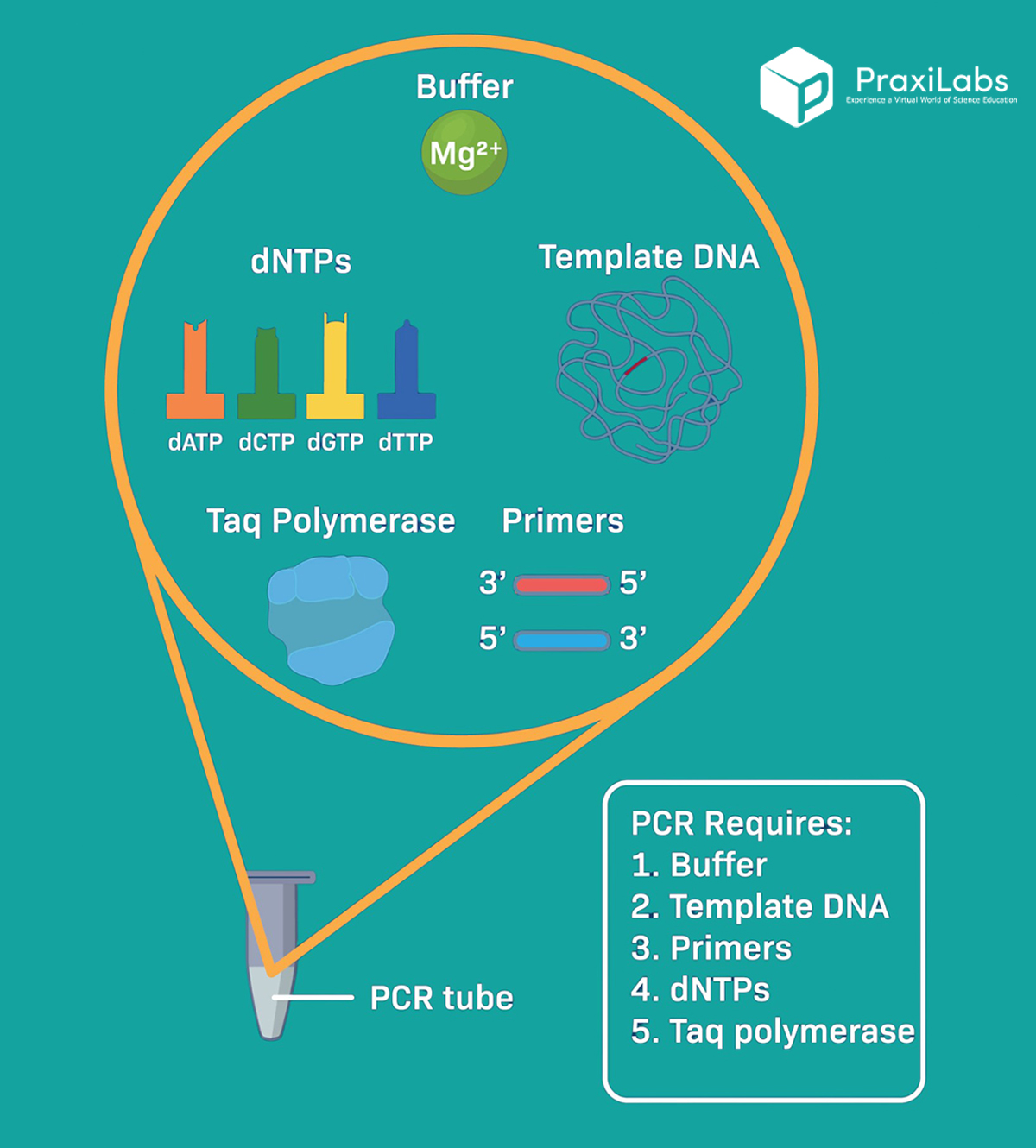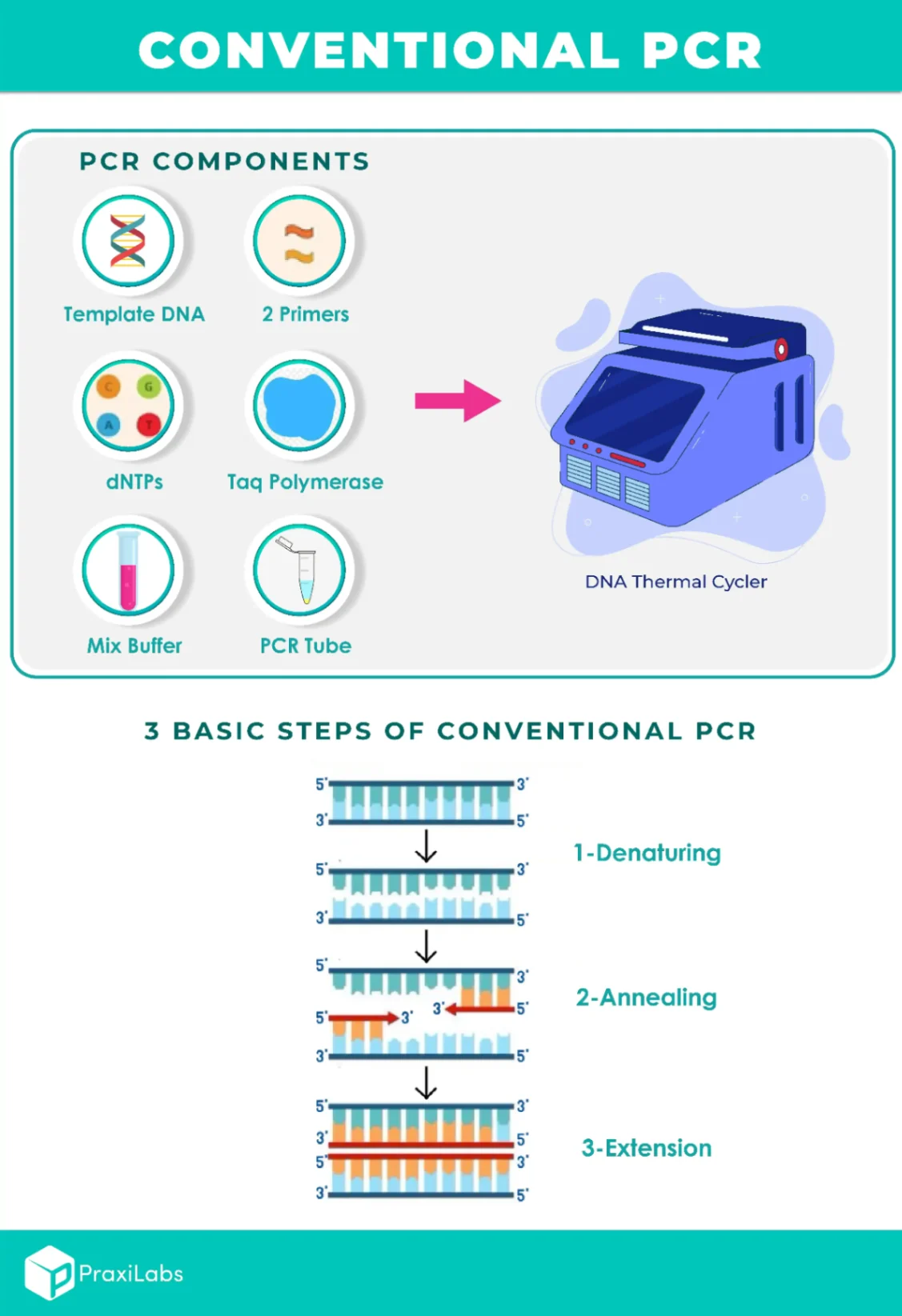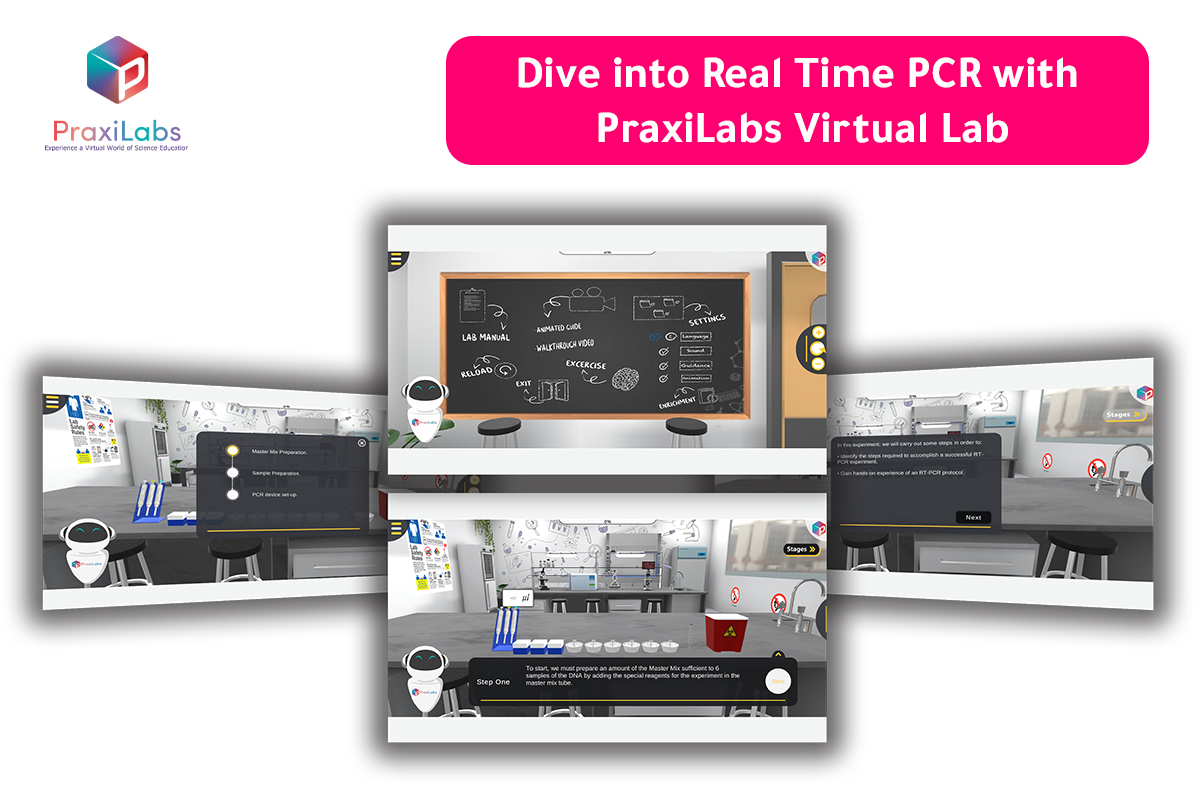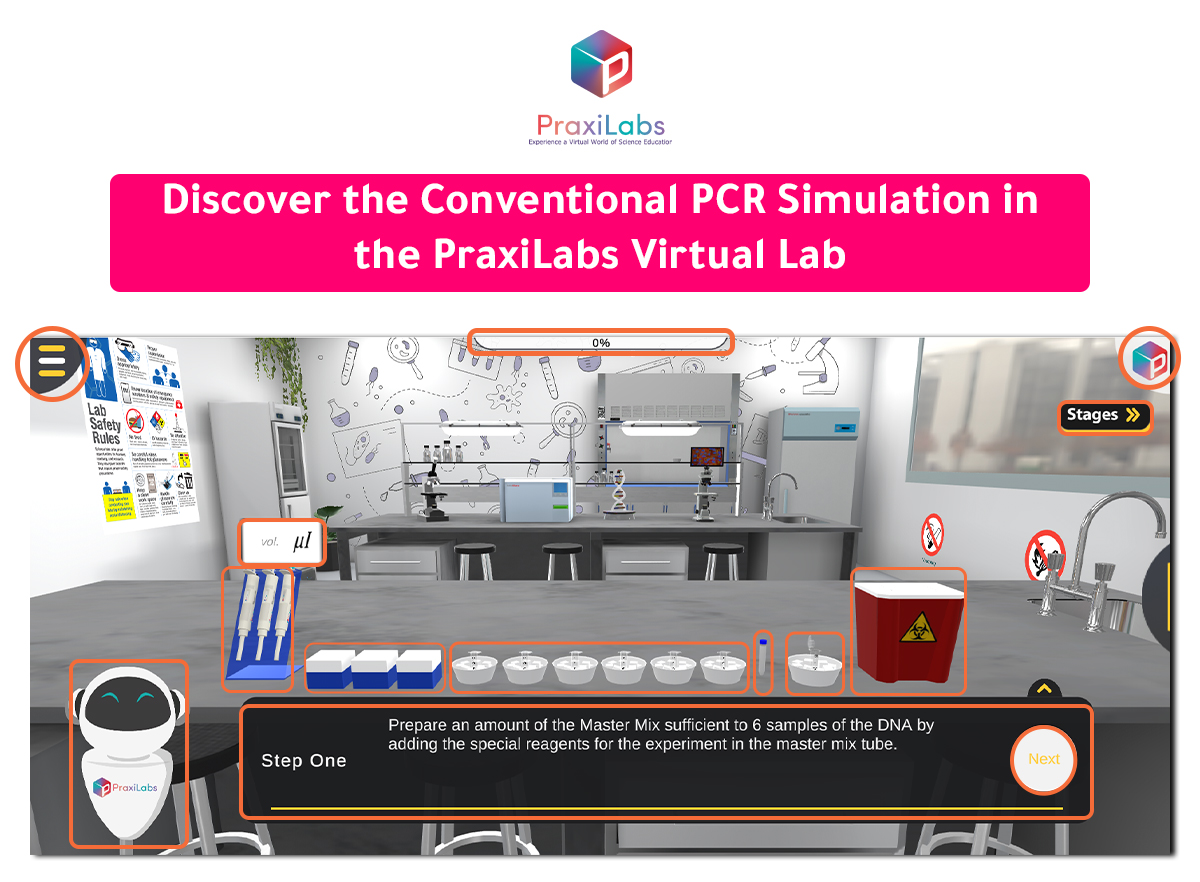Last Updated on October 28, 2025 by Muhamed Elmesery
PCR is a vital biological process capable of amplifying a single DNA molecule into millions of copies in a short time. We can define PCR technique as a test tube system for DNA replication or amplification, which allows a “target” DNA sequence to be selectively amplified several million -fold in just a few hours.
But what are the steps of PCR? What are the basics of PCR? What are the different types of PCR? What is the difference between conventional and real-time PCR?
In this blog, we’ll dive into the top questions surrounding the basics of PCR, demystifying this groundbreaking technique that has revolutionized science. Get ready to explore its principles, steps, requirements, and more.
Table of Contents
The Basics of PCR |The Answers to Your Most Pressing Questions!
What is the basic principle of PCR?
The basics of PCR principle relies on the ability of DNA polymerase enzyme to synthesize new strand of DNA complementary to the provided template strand. This process needs a primer which has the ability to add nucleotides, as DNA polymerase can add a nucleotide only onto a preexisting 3′-OH group. This requirement makes it possible to delineate a specific region of template sequence that the researcher wants to amplify. At the end of the PCR reaction, the specific sequence will have accumulated in billions of copies (amplicons).
Pick the Best Virtual Plan or You

What are the basic steps of PCR?
Initialization step
This step involves heating the reaction to a temperature of 94–96 °C (or 98 °C if extremely thermostable polymerases are used), which is maintained for 1–9 minutes. This step is only required for DNA polymerases that require heat activation by hot-start PCR.
Denaturation step
This step is the first regular cycling event and involves heating the reaction to 94–98 °C for 20–30 seconds. It causes the DNA template to melt by disrupting the hydrogen bonds between complementary bases, yielding single-stranded DNA molecules.
Annealing step
The reaction temperature is lowered to 50–65 °C for 20–40 seconds ,allowing annealing of the primers to the single-stranded DNA template.
Extension/elongation step
The temperature at this step depends on the DNA polymerase used; Taq polymerase has its optimum activity temperature at 75–80 °C ,and typically, a temperature of 72 °C is used with this enzyme. At this step, the DNA polymerase synthesizes a new DNA strand complementary to the DNA template strand by adding dNTPs that are complementary to the template in the 5′ to 3′ direction, condensing the 5′-phosphate group of the dNTPs with the 3′-hydroxyl group at the end of the nascent (extending) DNA strand. The extension time depends on both the DNA polymerase used and the length of the DNA fragment to be amplified.
Are you tired of seeing your students struggle to grasp complex scientific concepts? Request a Live Demo Now and Increase your Students’ Learning Retention and Engagement With PraxiLabs’ virtual labs!
What are the basics of PCR amplification?
The basics of PCR amplification are achieved by conducting three steps:
- Denaturation of the template (double-stranded DNA) into single strands by heating.
- Annealing of primers to each original strand for new strand synthesis by binding to the flanking regions of the target DNA.
- Extension of the new DNA strands from the primers, during the DNA polymerase extends the primer sequences from the 3′ end of each primer to the end of the amplicon.

What are the basic requirements of PCR technique?
A PCR setup requires several components and reagents. These components include:
- Two primers (forward and reverse).
- Template DNA.
- Taq polymerase enzyme.
- Deoxynucleoside triphosphates (dNTPs).
- Buffer solution.
- Distilled water.
- DNA thermal cycler.
- Pipettes.
- Eppendorf tubes.
What are the four major steps of PCR in order?
The four basics of PCR steps are:
First Step — Denaturation of the DNA template (double-stranded DNA) into two single strands by heat (at temperatures above 90 degrees Celsius). The heat breaks down hydrogen bonds between the base pairs, while the stronger bonds between deoxyribose and phosphates remain intact.
Second Step — Annealing of the primers to each original strand for new strand synthesis, The target DNA is targeted using primers that bind to the ends of the target DNA sequencing at temperatures 40 – 65 degrees Celsius depending on the base and length sequence of the primers.
Third Step — Extension: the temperature is increased to 72 degrees Celsius and “the enzyme Taq DNA polymerase” is used to replicate the DNA strands. During the extension step, two identical double stranded DNA molecules are synthesized. After the first PCR cycle, the process is generally repeated between 25 and 35 times.
Fourth Step — Analysis with gel electrophoresis, We can evaluate the amplified DNA and identify the nucleotide sequences by detecting the bands or ladder-like steps that migrate to the same levels in the gel.
HOW MANY COPIES OF DNA DOES PCR GENERATE?
The cycle of denaturing and synthesizing new DNA is repeated as many as 30 or 40 times (This repetition results in DNA amplification), leading to more than one billion copies of the original DNA segment.
What are the different types of PCR?
There are several types of PCR, such as:
- Conventional PCR.
- Hot-start PCR.
- Real-Time PCR (qPCR).
- AFLP PCR.
- Colony PCR.
- Digital PCR (dPCR).
- Reverse-Transcriptase (RT-PCR).
- Alu PCR.
- Allele-specific PCR.
- In situ PCR.
- Fast-cycling PCR.
- Assembly PCR.
- Asymmetric PCR.
- COLD PCR.
- High-fidelity PCR.
- Intersequence-specific (ISSR) PCR
- Inverse PCR.
- Repetitive sequence-based PCR.
- Methylation-specific PCR (MSP).
- LATE (linear after the exponential) PCR.
- Nested PCR.
- Overlap extension PCR.
- Suicide PCR.
- Nanoparticle-Assisted PCR (nanoPCR).
- Variable Number of Tandem Repeats (VNTR) PCR.
- Single cell PCR.
- Ligation-mediated PCR.
- Long-range PCR.
- RNase H-dependent PCR (rhPCR).
- Miniprimer PCR.
- Thermal asymmetric interlaced PCR (TAIL-PCR).
- Touch down (TD) PCR.
- Single Specific Primer-PCR (SSP-PCR).
- Reverse-Transcriptase Real-Time PCR (RT-qPCR).
- Solid phase PCR.
- Multiplex-PCR.
Why is Taq polymerase used in PCR?
PCR amplification works on the principle of temperature variation—heating and cooling reactions—which makes Taq polymerase used in PCR technique because it is a highly advantageous enzyme, it can work at high temperatures with high amplification capacity and efficiency.
Why is mgcl2 important in PCR?
Magnesium chloride (MgCl2) is an essential component of the PCR master mixture. It works as a cofactor, it improves the enzymatic activity of DNA polymerase, thereby boosting DNA amplification.
What is the difference between conventional and real-time PCR?
real-time PCR is much faster than conventional PCR, more sensitive compared to the conventional PCR, less time-consuming, less labor-intensive and also reduces the chance of contamination as there is no post-amplification procedure.
In conventional PCR, detection and quantification of the amplified sequence are performed at the end of the reaction after the last PCR cycle, and involve post-PCR analysis such as gel electrophoresis and image analysis. In real-time PCR, the popular PCR products are measured at each cycle.

On PraxiLabs, you can find different virtual lab simulations accessible anytime and anywhere.
What is Real Time PCR?
The polymerase chain reaction (PCR) is one of the most powerful technologies in molecular biology. In the real time PCR procedure, PCR products (amplicons) are dyed fluorescently and measured at each cycle. This allows the monitoring of the progress of the PCR reaction as it occurs; hence called real- time. A threshold cycle is the cycle number at which the fluorescent signal of the reaction crosses the threshold then through the standard curve the concentration of each sample can be calculated.
The advantages of real-time PCR:
- Ability to monitor the progress of the PCR reaction as it occurs in real time.
- Ability to precisely measure the amount of amplicon at each cycle, which allows highly accurate quantification of the amount of starting material in samples.
- An increased dynamic range of detection.
- Amplification and detection occur in a single tube, eliminating post-PCR manipulations

Hands-On Learning: Dive into Real Time PCR with PraxiLabs!
Help your students gain hands-on experience with the principle and practice of Real Time polymerase chain reaction (PCR)!
After performing a real time PCR simulation using PraxiLabs virtual biology lab, students will be able:
- Identify the steps required to accomplish a successful RT-PCR experiment.
- Gain hands-on experience of an RT-PCR protocol.

From Theory to Practice: Conventional PCR in the PraxiLabs Virtual Lab!
After performing a conventional PCR simulation using PraxiLabs virtual labs, students will be able:
- Demonstrate proficiency with the protocol involved in PCR.
- Identify the role of specific reagents and equipment in PCR.
- Practice basic laboratory techniques.
- Conclude downstream applications of PCR.
Gain hands-on experience with the principle and practice of conventional polymerase chain reaction (PCR)!
 PraxiLabs A virtual world of science
PraxiLabs A virtual world of science






